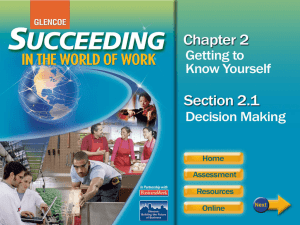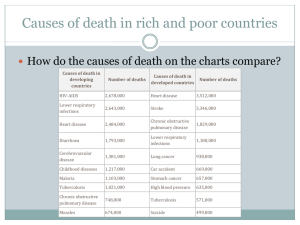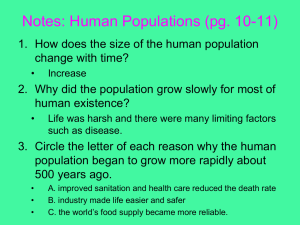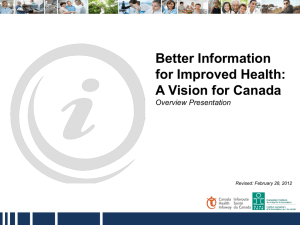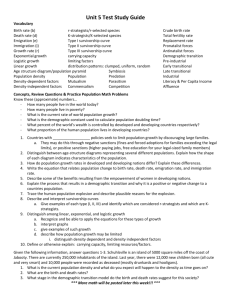Additional file 1 - Implementation Science
advertisement
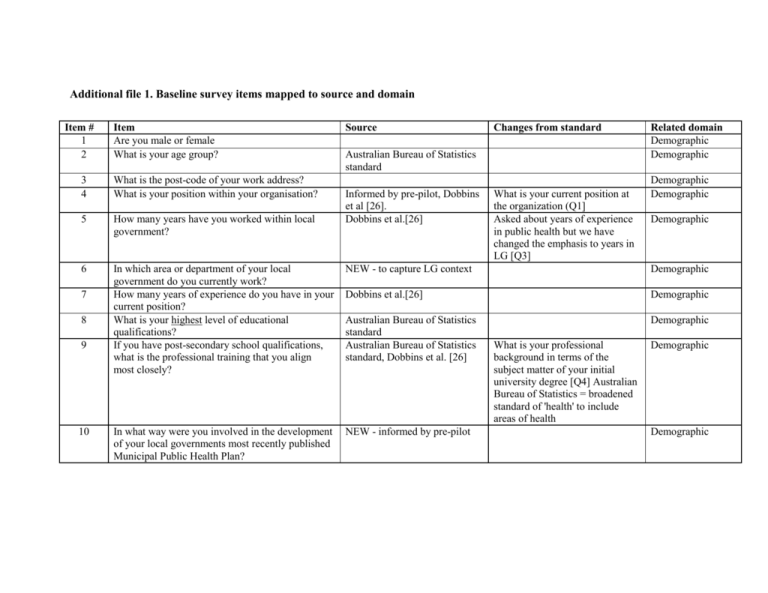
Additional file 1. Baseline survey items mapped to source and domain Item # 1 2 Item Are you male or female What is your age group? Source Changes from standard Australian Bureau of Statistics standard Related domain Demographic Demographic 3 4 What is the post-code of your work address? What is your position within your organisation? 5 How many years have you worked within local government? 6 In which area or department of your local government do you currently work? How many years of experience do you have in your current position? What is your highest level of educational qualifications? If you have post-secondary school qualifications, what is the professional training that you align most closely? NEW - to capture LG context Demographic Dobbins et al.[26] Demographic Australian Bureau of Statistics standard Australian Bureau of Statistics standard, Dobbins et al. [26] Demographic In what way were you involved in the development of your local governments most recently published Municipal Public Health Plan? NEW - informed by pre-pilot 7 8 9 10 Informed by pre-pilot, Dobbins et al [26]. Dobbins et al.[26] What is your current position at the organization (Q1] Asked about years of experience in public health but we have changed the emphasis to years in LG [Q3] What is your professional background in terms of the subject matter of your initial university degree [Q4] Australian Bureau of Statistics = broadened standard of 'health' to include areas of health Demographic Demographic Demographic Demographic Demographic Item # 11 Item It is easy for me to access the most relevant research findings available as I plan programs or policies Source Dobbins et al.[26] Changes from standard It is easy for you to access the most relevant research available as you plan programs or policies [Q24] Related domain Access 12 It is easy access to someone who can provide help in finding, interpreting and using research findings (e.g. librarian, epidemiologist or researcher) Dobbins et al.[26] I have easy access to someone who can provide help in interpreting or utilising research evidence [this person could be a librarian, epidemiologist, or academic - anyone who can help you to understand research] [Q19] Access 13 I have access to government reports that I need to inform decision-making 14 I have good access to academic literature that I need to inform decision-making? NEW - The following three items (13-15) were added to assess level of access to a range of sources of evidence. Although having access and knowing where to access are two different things. If these items are about knowledge then perhaps that needs to be the focus. Pre-tested items for knowledge and confidence were not identified. Used existing surveys [25, 26] to help construct these items NEW - see item 13 Access Item # 15 Item I have good access to synthesis or collations of academic literature e.g. systematic reviews that I need to inform decision-making How confident do you feel about your ability to find academic literature? Source NEW - see item 13 NEW – designed to collect data on confidence Confidence 17 How confident are you in assessing the quality or trustworthiness of sources of evidence? NEW - designed to collect data on confidence Confidence 18 Have you ever participated in training program/s that helped you to understand how to make judgements about the quality of research evidence? This content is sometimes referred to as critical appraisal [plus definition]. How confident are you in combining different sources of research evidence to inform decisionmaking e.g. different journal articles and reports? NEW – included to identify competency level Skills Overall, the culture in my LG is one that highly values the use of research evidence in decisionmaking for program planning Dobbins et al. [26] 16 19 20 NEW – based on diffusion of innovations theory [19] and informed by Weatherly et al. [25] Changes from standard What kind of evidence do you think would help to improve the decision-making process when faced with a choice between different interventions for either Coronary Heart Disease or Cancer? [Q21] Overall, the culture in my organization is one that highly values the use of research evidence in decision-making for program planning [Q16] Related domain Access Confidence Organisational culture Item # 21 Item Research evidence is consistently included in the decision-making process related to program planning, implementation and evaluation in my LG Source Dobbins et al.[26] Changes from standard Research evidence is consistently included in the decision-making process related to program planning, in my organization. [“included” means that it is one piece of information that is used in the decision-making process] [Q18] Related domain Organisational culture 22 This local government is influenced by research evidence when making decisions about public health programs Dobbins et al.[26] The governing board of my organization is influenced by research evidence when making decisions about public health programs. [“research evidence” refers to scientific studies] [Q21] Organisational culture 23 The following people and groups may INFLUENCE public health decision making. Please rate each item on the scale provided from not influential to very influential, as relevant to your local government. Weatherly et al.[25] For the HImP program that you have chosen to focus on, how important were the following sources of internal evidence in deciding what Coronary Heart Disease/Cancer services to provide to meet priorities identified [Q10] Influence Item # 24 Item The following resources may INFLUENCE public health decision making. Please rate each item on the scale provided from not influential to very influential, as relevant to your local government. Source Weatherly et al.[25] and informed by the pre-pilot. Changes from standard For the HImP program that you have chosen to focus on, how important were the following sources of internal evidence in deciding what Coronary Heart Disease/Cancer services to provide [Q11] Related domain 25 The following people and groups may be USEFUL in public health decision making. Please rate each item on the scale provided from not useful to very useful, as relevant to your local government. Usefulness 26 The following resources may be USEFUL in public Weatherly et al.[25] and health decision making. Please rate each item on informed by the pre-pilot. the scale provided from not useful to very useful, as relevant to your local government. Overall, which source of information has the Weatherly et al. [25] greater INFLUENCE on public health planning decisions in your local government? Usefulness 27 28 Overall, which source of information is most USEFUL for public health planning decisions in Weatherly et al. [25] Generally speaking, we are interested to know about the type of evidence used to decide which health care interventions to focus on (for either Coronary Heart Disease or Cancer). Would you say the evidence was internal evidence OR external evidence?[Q11] Generally speaking, we are interested to know about the type Influence Usefulness Item # 29 30 31-40 Item your local government? Source The following people and groups, as outlined Weatherly et al.[25] previously, may be involved in public health decision making related to obesity prevention in children. Focusing on decisions related to programs or activities for obesity prevention in children, please rate each item’s USEFULNESS on the scale provided, from not useful to very useful, as relevant to your local government. The following resources, as outlined previously, Weatherly et al. [25] may be involved in public health decision making related to obesity prevention in children. Focusing on decisions related to programs or activities for obesity prevention in children, please rate each item’s USEFULNESS on the scale provided, from not useful to very useful, as relevant to your local government. What do you think are the main barriers and Weatherly et al.[25] enablers to using research evidence in public health decision-making? 41 Describe one of the innovative ways your organisation shares knowledge about effective programs NEW – Informed by diffusion of innovations theory [19] 42 What additional strategies do you think would be useful to share evidence? NEW – Informed by diffusion of innovations theory [19] Changes from standard of evidence used to decide which health care interventions to focus on (for either Coronary Heart Disease or Cancer). Would you say the evidence was internal evidence OR external evidence?[Q11] Related domain Usefulness Usefulness What do you think are the main barriers to using evidence in HImP design are? [Q20] Barriers and facilitators Describing current practice and informing intervention design Describing current practice and Item # 43 Item Source Overall, how do you feel you could be better supported to make use of evidence in your role? NEW – Included to inform intervention design Changes from standard Related domain informing intervention design Describing current practice and informing intervention design



